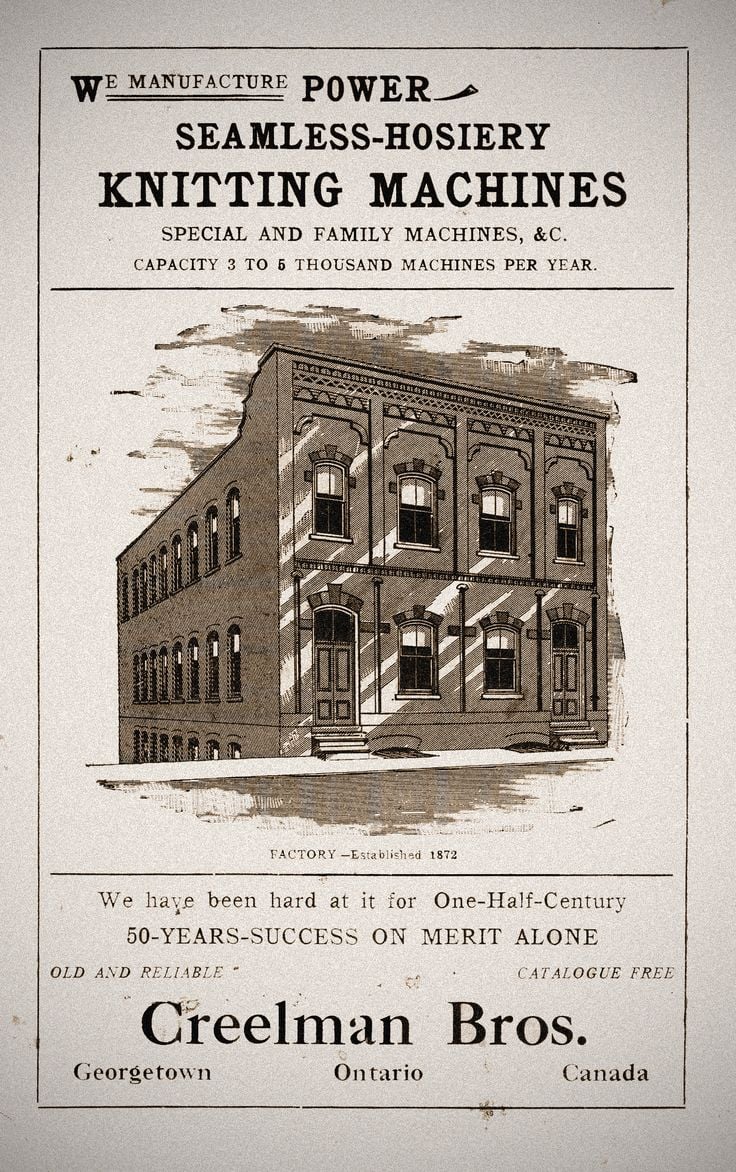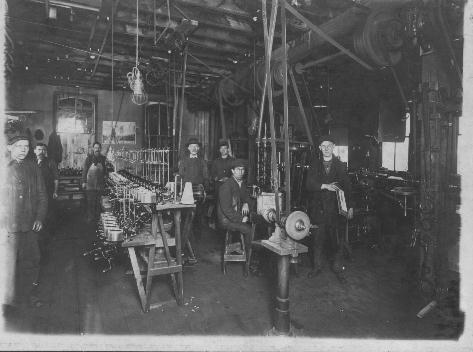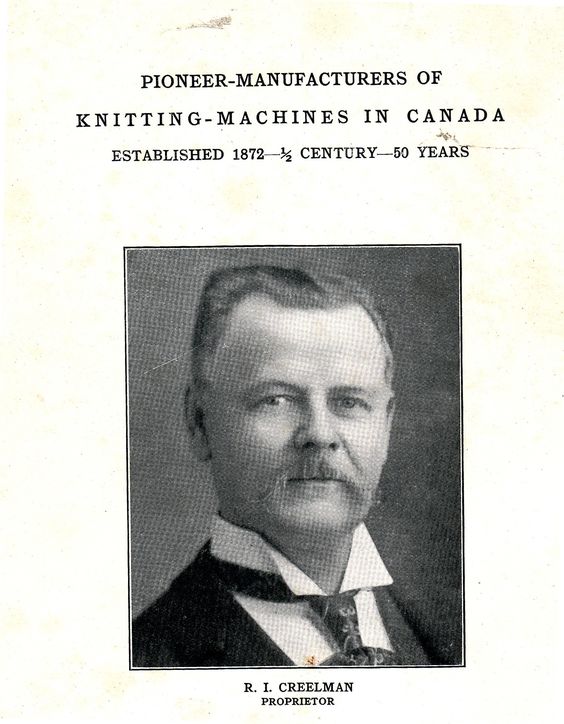Creelman Brothers
This article first appeared in the Georgetown Independent, October 2, 1985
Richard Irving Creelman was born in Grey County, Ontario in 1852 and later educated at the Rockwood Academy. Together with his brother, Robertson, he started a stationary business in Georgetown in 1872. Apart from paper supplies, they stocked a wide variety of other goods including books, musical instruments, sewing machines and were probably the local agents for the Franz and Pope knitting machines.
In May 1876 the Creelman Brothers announced that they were forming a company for the manufacture of knitting machines to be the first company of its kind in Canada.1
While their first location is now unknown, in 1881 the brothers purchased the Travis building on Georgetown's Main Street. Elijah Travis' planing mill was taken down and a brick, three story knitting machine factory was erected on the site.
Five years later this building was partially destroyed by fire. $9000 damage was caused by the fire and the desperate efforts of the fire brigade to douse the flames led to considerable water damage in the machine room and in the Georgetown Herald office on the second floor.2 Reconstruction was going to be expensive and the local news reports did not mention how well the building and its contents were covered by insurance. Whether Creelmans went fishing for a bonus or whether some sharp eyed councillor spotted a news report and sent them a letter is unclear, but a few months later the brothers were prepared to move the firm to Ingersoll for a bonus of $5000 and a $12,000 loan at 5% interest.3
Creelman Brothers Knitting Machine Staff
After a nasty accident with a pistol (he shot himself in the palm of the hand), Richard Creelman went abroad for several years drumming up business. This quickly paid off, as the firm began reporting orders from as far away as France, Spain, and New Zealand. Indeed Creelman power knitting machines could be found in knitting mills all across the country, except, for some reason, in Glen Williams where Ben Williams had imported equipment from Massachusetts.4
In April 1890 the two brothers went their separate ways. Robertson Creelman moved to Collingwood and set up in the stationary business again.6 Nevertheless the firm would still be known as Creelman Brothers. Shortly after Robertson's departure, the firm also began making and selling typewriters.
In 1893 the Creelman Brothers were one of the firms described in a four page feature article on the town of Georgetown which appeared in the Toronto Daily Mail:
Creelman Brothers were pioneer knitting machine manufacturers in Canada. They have seen nine competitors fail. Just recently they have purchased the plant of Kay & Co., manufacturers of standard, transfer, needle, ribber and other machines and now have the most complete knitting machine plant on this continent. This firm attributes its success to its ability to design original, practicable, and patentable, improvements of superior merit. Its facilities for turning out valuable machines at the lowest possible price has enabled it to not only hold its trade, but secure a large foreign trade in spite of all competition.
It manufactures twenty styles of machines for plain, seamless hosiery, and for ribbed-full fashion seamless hosiery, gloves & mitts; automatic rib top machines, power wringers & fullers, and steam hosiery presses; its principal trade however, being in hand & power manufacturing and family machines. In the latter the firm claims to have solved the question of how to build a cheap and practical machine, which it is putting on the market this year for the first time at ten dollars, a price low beyond precedent. It is called the money-maker, and will prove itself a friend to many a weary mother and is eminently worthy of its suggestive name.7
The "money-maker" was a special design of machine for use in the home. In addition to the ten dollar model, Creelmans also made more expensive versions for sale at $18.25 and $25.00. On these models Creelmans gave coupons for $2.00 off the price of the machine if the buyer paid in cash.8 The firm claimed that their machines designed for use in the home were so simple to use that a child or a blind person could use them. By 1913 the firm had developed a line of six family knitting machines ranging in price from twenty to sixty dollars.9 Most of the machines could be fastened to the kitchen table, but if you did not want to do that the company sold an oak top "Banner" stand for the machine. The knitting machine could be hidden in the top of the stand when not in use.
In 1923 the firm changed its name to Creelman Limited. By this time Richard's son Clifford was involved with the business. Three years later the firm was put up for sale due to the declining health of its founder and the lack of capital.10 If nobody was ordered to take over the entire concern, the Creelmans were ready to divide it into three units, the latch needle business, the family knitting machines and the power knitting machines and hosiery mill specialties.
Richard Irving Creelman died in June 1932. In addition to being one of the founders of the Creelman Brothers Knitting Machine Company, he was involved with various other businesses including the Creelman Brothers Typewriter Company. This was later bought out by United Typewriter Co., of which Richard Creelman became vice-president. At other times he served as the secretary of the Georgetown Floral Company and of the Credit Valley Brick Co., as a director of Sovereign Life Insurance and as president of Canada Needle Works.11
The Creelman home still stands on the west side of Main Street North. It is the first brick house on the west side after you have gone north on the railway bridge.
After Creelman Brothers moved out of the factory it housed a variety of businesses. John Cordaro ran a candy company there from roughly 1948 to 1957. Other businesses that have been housed in the building include the Herald, a fish and chip shop, a barber shop, a photo studio, a clothing store, a t.v. and appliance store and an instrument company. 12
In 1966 Sid Silver acquired the building from John Cordaro. He had intended to pull down the old building and erect new offices and stores but before demolition could begin the structure was destroyed by fire. Some of the businesses that now stand on the former site of the Creelman Building include Fletcher's Family Shoe Store and William Ellis Real Estate Ltd.
Richard Irving Creelman was born in Grey County, Ontario in 1852 and later educated at the Rockwood Academy. Together with his brother, Robertson, he started a stationary business in Georgetown in 1872. Apart from paper supplies, they stocked a wide variety of other goods including books, musical instruments, sewing machines and were probably the local agents for the Franz and Pope knitting machines.
In May 1876 the Creelman Brothers announced that they were forming a company for the manufacture of knitting machines to be the first company of its kind in Canada.1
While their first location is now unknown, in 1881 the brothers purchased the Travis building on Georgetown's Main Street. Elijah Travis' planing mill was taken down and a brick, three story knitting machine factory was erected on the site.
Five years later this building was partially destroyed by fire. $9000 damage was caused by the fire and the desperate efforts of the fire brigade to douse the flames led to considerable water damage in the machine room and in the Georgetown Herald office on the second floor.2 Reconstruction was going to be expensive and the local news reports did not mention how well the building and its contents were covered by insurance. Whether Creelmans went fishing for a bonus or whether some sharp eyed councillor spotted a news report and sent them a letter is unclear, but a few months later the brothers were prepared to move the firm to Ingersoll for a bonus of $5000 and a $12,000 loan at 5% interest.3
Creelman Brothers Knitting Machine Staff
After a nasty accident with a pistol (he shot himself in the palm of the hand), Richard Creelman went abroad for several years drumming up business. This quickly paid off, as the firm began reporting orders from as far away as France, Spain, and New Zealand. Indeed Creelman power knitting machines could be found in knitting mills all across the country, except, for some reason, in Glen Williams where Ben Williams had imported equipment from Massachusetts.4
In April 1890 the two brothers went their separate ways. Robertson Creelman moved to Collingwood and set up in the stationary business again.6 Nevertheless the firm would still be known as Creelman Brothers. Shortly after Robertson's departure, the firm also began making and selling typewriters.
In 1893 the Creelman Brothers were one of the firms described in a four page feature article on the town of Georgetown which appeared in the Toronto Daily Mail:
Creelman Brothers were pioneer knitting machine manufacturers in Canada. They have seen nine competitors fail. Just recently they have purchased the plant of Kay & Co., manufacturers of standard, transfer, needle, ribber and other machines and now have the most complete knitting machine plant on this continent. This firm attributes its success to its ability to design original, practicable, and patentable, improvements of superior merit. Its facilities for turning out valuable machines at the lowest possible price has enabled it to not only hold its trade, but secure a large foreign trade in spite of all competition.
It manufactures twenty styles of machines for plain, seamless hosiery, and for ribbed-full fashion seamless hosiery, gloves & mitts; automatic rib top machines, power wringers & fullers, and steam hosiery presses; its principal trade however, being in hand & power manufacturing and family machines. In the latter the firm claims to have solved the question of how to build a cheap and practical machine, which it is putting on the market this year for the first time at ten dollars, a price low beyond precedent. It is called the money-maker, and will prove itself a friend to many a weary mother and is eminently worthy of its suggestive name.7
The "money-maker" was a special design of machine for use in the home. In addition to the ten dollar model, Creelmans also made more expensive versions for sale at $18.25 and $25.00. On these models Creelmans gave coupons for $2.00 off the price of the machine if the buyer paid in cash.8 The firm claimed that their machines designed for use in the home were so simple to use that a child or a blind person could use them. By 1913 the firm had developed a line of six family knitting machines ranging in price from twenty to sixty dollars.9 Most of the machines could be fastened to the kitchen table, but if you did not want to do that the company sold an oak top "Banner" stand for the machine. The knitting machine could be hidden in the top of the stand when not in use.
In 1923 the firm changed its name to Creelman Limited. By this time Richard's son Clifford was involved with the business. Three years later the firm was put up for sale due to the declining health of its founder and the lack of capital.10 If nobody was ordered to take over the entire concern, the Creelmans were ready to divide it into three units, the latch needle business, the family knitting machines and the power knitting machines and hosiery mill specialties.
Richard Irving Creelman died in June 1932. In addition to being one of the founders of the Creelman Brothers Knitting Machine Company, he was involved with various other businesses including the Creelman Brothers Typewriter Company. This was later bought out by United Typewriter Co., of which Richard Creelman became vice-president. At other times he served as the secretary of the Georgetown Floral Company and of the Credit Valley Brick Co., as a director of Sovereign Life Insurance and as president of Canada Needle Works.11
The Creelman home still stands on the west side of Main Street North. It is the first brick house on the west side after you have gone north on the railway bridge.
After Creelman Brothers moved out of the factory it housed a variety of businesses. John Cordaro ran a candy company there from roughly 1948 to 1957. Other businesses that have been housed in the building include the Herald, a fish and chip shop, a barber shop, a photo studio, a clothing store, a t.v. and appliance store and an instrument company. 12
In 1966 Sid Silver acquired the building from John Cordaro. He had intended to pull down the old building and erect new offices and stores but before demolition could begin the structure was destroyed by fire. Some of the businesses that now stand on the former site of the Creelman Building include Fletcher's Family Shoe Store and William Ellis Real Estate Ltd.


